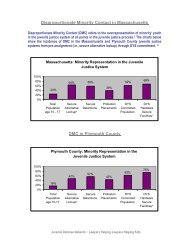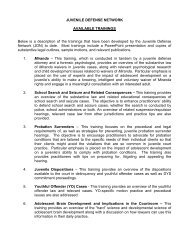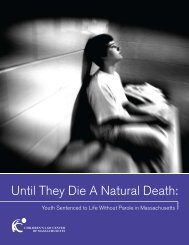States rethink 'adult time for adult crime' - the Youth Advocacy Division
States rethink 'adult time for adult crime' - the Youth Advocacy Division
States rethink 'adult time for adult crime' - the Youth Advocacy Division
You also want an ePaper? Increase the reach of your titles
YUMPU automatically turns print PDFs into web optimized ePapers that Google loves.
M’Naughten case in 1843, involving a paranoid British assassin, English and<br />
American courts have recognized an insanity defense only <strong>for</strong> those who are<br />
unable to appreciate <strong>the</strong> difference between right and wrong. (This is consistent<br />
with <strong>the</strong> idea that only rational people can be held criminally responsible <strong>for</strong> <strong>the</strong>ir<br />
actions.) According to some neuroscientists, that rule makes no sense in light of<br />
recent brain-imaging studies. “You can have a horrendously damaged brain<br />
where someone knows <strong>the</strong> difference between right and wrong but none<strong>the</strong>less<br />
can’t control <strong>the</strong>ir behavior,” says Robert Sapolsky, a neurobiologist at Stan<strong>for</strong>d.<br />
“At that point, you’re dealing with a broken machine, and concepts like<br />
punishment and evil and sin become utterly irrelevant. Does that mean <strong>the</strong><br />
person should be dumped back on <strong>the</strong> street Absolutely not. You have a car with<br />
<strong>the</strong> brakes not working, and it shouldn’t be allowed to be near anyone it can<br />
hurt.”<br />
Even as <strong>the</strong>se debates continue, some skeptics contend that both <strong>the</strong> hopes and<br />
fears attached to neurolaw are overblown. “There’s nothing new about <strong>the</strong><br />
neuroscience ideas of responsibility; it’s just ano<strong>the</strong>r material, causal explanation<br />
of human behavior,” says Stephen J. Morse, professor of law and psychiatry at<br />
<strong>the</strong> University of Pennsylvania. “How is this different than <strong>the</strong> Chicago school of<br />
sociology,” which tried to explain human behavior in terms of environment and<br />
social structures “How is it different from genetic explanations or psychological<br />
explanations The only thing different about neuroscience is that we have prettier<br />
pictures and it appears more scientific.”<br />
Morse insists that “brains do not commit crimes; people commit crimes” — a<br />
conclusion he suggests has been ignored by advocates who, “infected and<br />
inflamed by stunning advances in our understanding of <strong>the</strong> brain . . . all too often<br />
make moral and legal claims that <strong>the</strong> new neuroscience . . . cannot sustain.” He<br />
calls this “brain overclaim syndrome” and cites as an example <strong>the</strong> neuroscience<br />
briefs filed in <strong>the</strong> Supreme Court case Roper v. Simmons to question <strong>the</strong> juvenile<br />
death penalty. “What did <strong>the</strong> neuroscience add” he asks. If adolescent brains<br />
caused all adolescent behavior, “we would expect <strong>the</strong> rates of homicide to be <strong>the</strong><br />
same <strong>for</strong> 16- and 17-year-olds everywhere in <strong>the</strong> world — <strong>the</strong>ir brains are alike —<br />
but in fact, <strong>the</strong> homicide rates of Danish and Finnish youths are very different<br />
than American youths.” Morse agrees that our brains bring about our behavior —<br />
“I’m a thoroughgoing materialist, who believes that all mental and behavioral
















